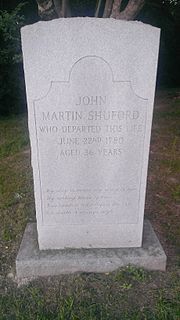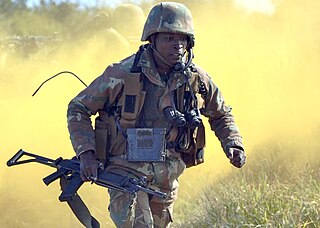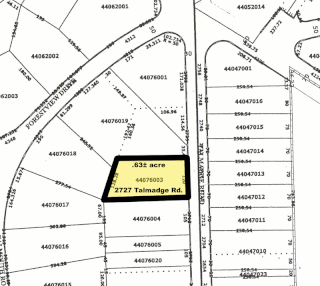Francis Nash was a brigadier general in the Continental Army during the American Revolutionary War. Prior to the war, he was a lawyer, public official, and politician in Hillsborough, North Carolina, and was heavily involved in opposing the Regulator movement, an uprising of settlers in the North Carolina piedmont between 1765 and 1771. Nash was also involved in North Carolina politics, representing Hillsborough on several occasions in the colonial North Carolina General Assembly.

Richard Caswell was the first and fifth governor of the U.S. State of North Carolina, serving from 1776 to 1780 and from 1785 to 1787. He was also major general over all North Carolina militia in 1780 and from 1781 to 1783.

Benjamin Williams was the 11th and 14th Governor of the U.S. state of North Carolina, from 1799 to 1802 and from 1807 to 1808. He was the first of two North Carolina Governors since the American Revolution to serve nonconsecutive terms.
Lieutenant Colonel John Montgomery was an American soldier, settler and explorer. He is credited with founding the city of Clarksville, Tennessee. Montgomery County, Tennessee is named after him.
The 4th North Carolina Regiment was authorized on January 16, 1776 and established on April 15, 1776 at Wilmington, North Carolina for service with the Continental Army Southern Department under the command of Thomas Polk. The regiment saw action at the Battle of Brandywine, Battle of Germantown, Battle of Monmouth and the Siege of Charleston. The regiment was captured by the British Army at Charlestown, South Carolina, on May 12, 1780. The regiment was disbanded on January 1, 1783.

The 84th Regiment of Foot was a British regiment in the American Revolutionary War that was raised to defend present day Ontario, Quebec and Atlantic Canada from the constant land and sea attacks by American Revolutionaries. The 84th Regiment was also involved in offensive action in the Thirteen Colonies; including North Carolina, South Carolina, Georgia, Virginia and what is now Maine, as well as raids upon Lake Champlain and the Mohawk Valley. The regiment consisted of 2,000 men in twenty companies. The 84th Regiment was raised from Scottish soldiers who had served in the Seven Years' War and stayed in North America. As a result, the 84th Regiment had one of the oldest and most experienced officer corps of any regiment in North America. The Scottish Highland regiments were a key element of the British Army in the American Revolution. The 84th Regiment was clothed, armed and accoutred the same as the Black Watch, with Lieutenant Colonel Allan Maclean commanding the first battalion and Major General John Small of Strathardle commanding the second. The two Battalions operated independently of each other and saw little action together.

The North Carolina Line refers to North Carolina units within the Continental Army. The term "North Carolina Line" referred to the quota of infantry regiments assigned to North Carolina at various times by the Continental Congress. These, together with similar contingents from the other twelve states, formed the Continental Line. The concept was particularly important in relation to the promotion of commissioned officers. Officers of the Continental Army below the rank of brigadier general were ordinarily ineligible for promotion except in the line of their own state.
James Armstrong (1728–1800) was a state representative in the Georgia House of Representatives from 1787–1790. Before this, he served in the Continental Army, in the 2nd Pennsylvania Regiment, 3rd Pennsylvania Regiment, and Lee's Legion, rising to the rank of captain during the war. He was captured in 1781 by the British, in South Carolina, and remained a prisoner until the end of the war. During the United States presidential election of 1788–89 he received one electoral vote. He died in 1800.

The Battle of Ramsour's Mill took place on June 20, 1780 in present-day Lincolnton, North Carolina, during the British campaign to gain control of the southern colonies in the American Revolutionary War. The number of fighters on each side of the battle is still an issue of contention, but Loyalist militiamen outnumbered Patriot militia and had captured a group of Patriots who they were planning to hang on the morning of June 20.
The Rowan County Regiment was originally established in about August 1, 1775 as a local militia in Rowan County in the Province of North-Carolina. When the North Carolina Provincial Congress authorized thirty-five existing county militias to be organized on September 9, 1775, the Rowan County Regiment was included and all officers were appointed with commissions from the Provincial Congress. The members of the Rowan County Regiment were mostly from what was Rowan County at the time. Prior to establishment of the Rowan County Regiment, many of it's officers were active in the Rowan County Committee of Safety. After the establishment of the Rowan County Regiment, several other counties were created from Rowan County, including Surry County in 1771, Burke County in 1777, Iredell County in 1788, Davidson County in 1822 and Davie County in 1836.
The 2nd Rowan County Regiment was first established in October 22, 1775 as a local militia in Rowan County in the Province of North-Carolina. This regiment was created from the existing Rowan County Regiment of militia. Its original officers were Col Adlai Osborne, Lt Col Christopher Beekman, and Major Charles McDowell. Adlai Osborne was a leader in Rowan County and member of the Rowan County Committee of Safety.
The Lincoln County Regiment was a local militia in Lincoln County, North Carolina during the American Revolutionary. It was created by the North Carolina General Assembly on February 8, 1779 at the same time that Lincoln County was created from part of Tryon County. The Tryon County Regiment from which the Lincoln County Regiment was created was abolished upon creation of the Lincoln County Regiment. The Lincoln County Regiment was initially subordinate to the Salisbury District Brigade. It was re-subordinated to the newly created Morgan District Brigade in may of 1782, where it was active till the end of the war.
The Mecklenburg County Regiment was authorized on May 31, 1775 by the Province of North Carolina Congress. From November 7, 1779 until the 3rd Quarter of 1780, it was called the 1st Mecklenburg County Regiment when a 2nd Mecklenburg County Regiment existed. The 1st Mecklenburg County regiment was engaged in 39 known battles and skirmishes against the British during the American Revolution in North Carolina, South Carolina and Georgia between 1776 and 1781. It was active until the end of the war.
The Edenton District Brigade was an administrative division of the North Carolina militia during the American Revolutionary War (1776–1783). This unit was established by the North Carolina Provincial Congress on May 4, 1776, and disbanded at the end of the war.
The Wilmington District Brigade was an administrative division of the North Carolina militia during the American Revolutionary War (1776–1783). This unit was established by the North Carolina Provincial Congress on May 4, 1776, and disbanded at the end of the war.
The New Bern District Brigade was an administrative division of the North Carolina militia during the American Revolutionary War (1776–1783). This unit was established by the North Carolina Provincial Congress on May 4, 1776, and disbanded at the end of the war.
James Brandon (1734-1790) was an early pioneer in Rowan County, North Carolina and an officer in the North Carolina militia during the American Revolution. He commanded the 2nd Rowan County Regiment from 1782-1783.
The Wayne County Regiment was a unit of the North Carolina militia that served during the American Revolution. The North Carolina General Assembly created Wayne County and its regiment of militia out of part of Dobbs County and its regiment of militia on November 2, 1779. The officers were appointed and commissioned by the Governor of North Carolina. The regiment was disbanded at the end of the war.










